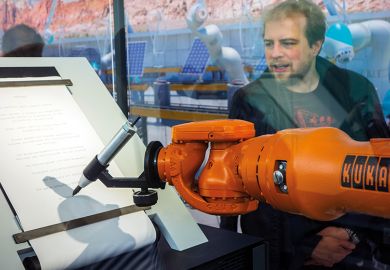I’m coining a new term for scientific writing – “The J. Stat. Mech. Motherboard rule” – and I’m defining it here.
But first, some context. Across disciplines, scientific writing is hard. Not to be confused with science writing (which is what you read in the science section of, say, The New York Times, written primarily by journalists), scientific writing is produced by practising scientists for other practising scientists, and it’s what you read in Science and Nature and the thousands of other scientific journals making up scientific literature.
By its very nature, scientific writing is often highly technical and filled with jargon. It can be dense, opaque and impenetrable, even to its intended scientific audience. As a lecturer of scientific writing, I spend a lot of time thinking about not only how to write the clearest scientific prose possible, but how to convince scientists that clear prose is a valuable and worthwhile goal. Sometimes I get pushback. One resistant line of thinking goes: “Yes, my manuscript is highly technical and uses a lot of jargon, but that’s unavoidable. The science is complicated, so the writing is going to be complicated.”
A common response to this stance, sometimes intended for authors of more general science writing, is, “Write as if you were explaining this to your grandmother.”
First of all, some grandmothers do have PhDs in science, so this is an unflattering recommendation that smacks of sexism and ageism. But also, such a rebuttal is ultimately poor advice. We should not be writing articles for Science in a way that is accessible to readers without a science background. That would be painful for the actual intended audience to read – nobody with a PhD in chemistry needs to read an analogy-filled explanation of “What is an atom?” to get to the central proposition of a chemistry paper.
To use a common tool of general science writing, I’ll help you to visualise my principle. Imagine you have a dial. On one end of the dial is the “write so anyone can understand it” mode, where you explain everything in painstakingly detailed metaphors and assume that your reader knows very little.
On the other end of the dial is “write only for yourself” mode, where you pack in all the obscure jargon that you picked up during your PhD studies and assume that your reader is right there with you. On one end is wide accessibility but writing that is pretty tedious for actual scientists to read. On the other end is low accessibility but an article that gets to the point for people who already know exactly what you are talking about.
As practising scientists and writers, where should we set our dial?
The J. Stat. Mech. Motherboard rule suggests that for most scientists the happy medium is to write as if you want your article to get picked up by a science-interest mainstream publication, for example Motherboard.
Motherboard is a science/tech magazine produced by Vice that defines itself thus: “Whether on the ground or on the web, Motherboard travels the world to uncover the tech and science stories that define what’s coming next for this quickly evolving planet of ours.”
What makes Motherboard so relevant here is that it often will dive into relatively obscure topics, and – let’s face it – a lot of scientists work on obscure topics.
For example, the Motherboard article “Researchers discover a pattern to the seemingly random distribution of prime numbers”, with the subheading “The pattern has a surprising similarity to the one seen in atom distribution in crystals”, talks about prime numbers and crystallography, even boasting a diagram of an X-ray diffractometry experiment. That’s some pretty technical stuff for a mainstream science-interest publication.
The source article for the story is “Uncovering multiscale order in the prime numbers via scattering” from the Journal of Statistical Mechanics: Theory and Experiment (J. Stat. Mech.). I’ll bet that after seeing the Motherboard article, the J. Stat. Mech. authors were pleased with themselves, not least because mainstream media coverage increases citations of scientific papers that have been sources for articles.
This story shows that even for theoretical statistical mechanics, multi-scale prime number order and crystallography, there is a general-interest audience out there who can be enticed by the topic.
Furthermore, the source article was not Science or Nature; it was an extremely specialised journal for a very specific technical audience. This means that no scientific writers – no matter how specialised – should be able to get away with excuses related to the highly technical nature of their topic. All technical writing is improved by making it more accessible – as long as we’re not completely re-explaining the very basics.
Social scientists, life scientists, physical scientists, computational scientists, all scientists should set the dial snugly between expert and clueless in order to compromise between accessibility and efficiency. You should write your manuscript as if you hope to get picked up as a source article for a story in Motherboard, even if you’re writing for a specialised publication such as the Journal of Statistical Mechanics.
The key to the J. Stat. Mech. Motherboard rule is to remember that you’re not starting from zero (the audience does have an interest in science) but you’re not going to get there with an opening sentence suited for your closest collaborator. That’s the method. Use it and profit.
Philip Rodenbough is a lecturer of scientific writing at New York University Abu Dhabi.
POSTSCRIPT:
Print headline: A jargon-busting manifesto
Register to continue
Why register?
- Registration is free and only takes a moment
- Once registered, you can read 3 articles a month
- Sign up for our newsletter
Subscribe
Or subscribe for unlimited access to:
- Unlimited access to news, views, insights & reviews
- Digital editions
- Digital access to THE’s university and college rankings analysis
Already registered or a current subscriber?




